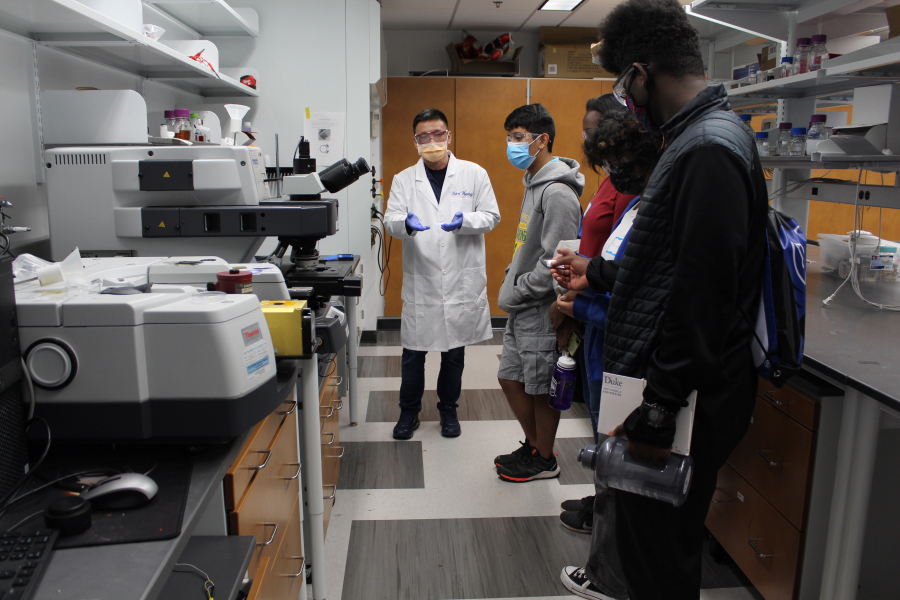DURHAM – Students from the North Carolina School of Science and Mathematics (NCSSM) in Durham recently got to see firsthand how different materials emit different amounts of infrared light (IR), which is ordinarily invisible to the naked eye. In the process, they also got glimpses of the Duke University campus labs and materials science facilities, so they could envision themselves as future engineers.
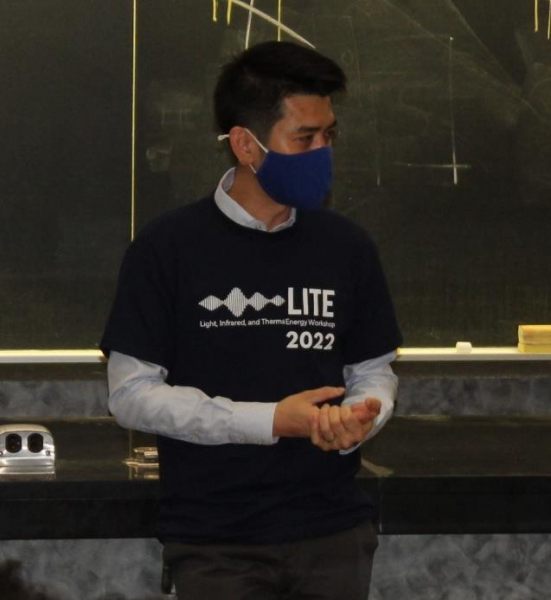
Po-Chun Hsu sported the LITE 2022 logo t-shirt as he welcomed participants.
Po-Chun Hsu, assistant professor of mechanical engineering and materials science, and members of his lab group created and hosted a one-day outreach event called LITE: Light, Infrared and Thermal Energy.
“Our goal was to educate and inspire higher educational career paths in the fields of optics and materials science for sustainable energy among 9th– and 10th-graders,” Hsu said.
The idea of having a workshop dedicated to light and thermal radiation originated around five years ago when Hsu was a PhD student, he said. The field to control light and heat for sustainable energy applications involves a tremendous amount of cross-disciplinary work and he started noticing some gaps across different fields. You might say this event was about shedding light on the importance of collaboration across fields for students who seem destined for careers in science, technology, engineering or mathematics (STEM) by virtue of their enrollment in this rigorous STEM high school.
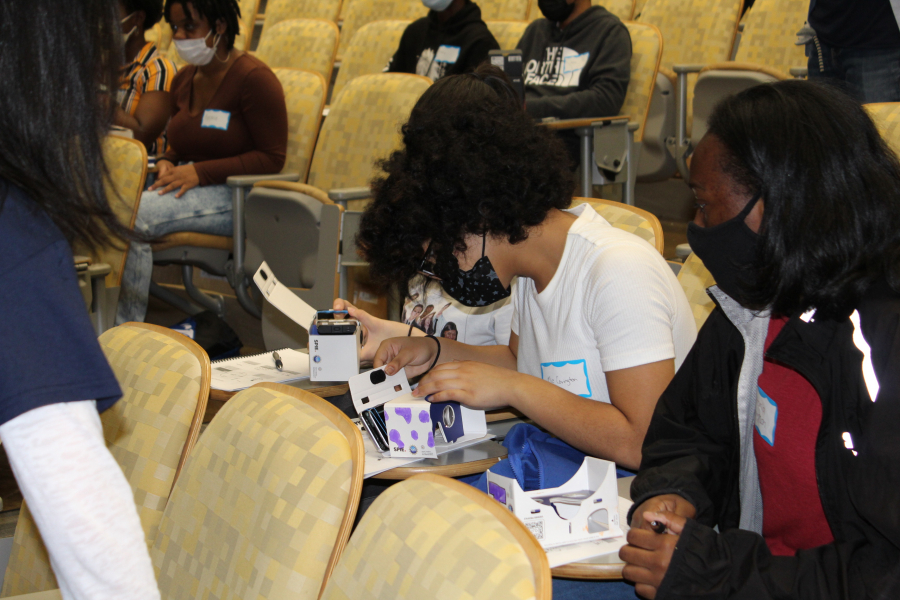
Assembling the thermal-sensing, virtual-reality cardboard headsets
The eager participants began the Saturday event by assembling thermal-imaging, virtual-reality (VR) Google cardboard goggles – like the ones used in the movie Predator – in which they inserted their cell phones and “viewed” IR in the form of heat signatures while learning about blackbody radiation, emissivity and radiative cooling.
Throughout the day, they used their goggles to view different objects in IR, including an aluminum suit worn by Hsu Lab member Keyu Wang that reflects IR and Leslie cubes, which have each side coated with a different material, such as matte black, matte silver, shiny silver and bronze. Each of these materials emits different levels of IR, explained Genesis Higueros, a PhD candidate in the Hsu Lab who organized and led much of the workshop and even designed the logo printed on their t-shirts.

The student at left uses his thermal-sensing headset to measure the infrared radiation emitted by the Leslie cube held by the student at right.
The students also toured Duke’s Shared Materials Instrumentation Facility (SMiF) and the Hsu Lab before watching an outdoor demonstration of a solar energy device presented by a Duke Engineering undergraduate senior capstone team.
“The experience was amazing,” said Gerri Cole, associate director of STEM Outreach at NCSSM, who accompanied the students. “I was asking the students about their experience, and a lot of them are inspired and want to join Duke in the future.”
Ethan Moreno, a 9th-grader, said using the Leslie cube was his favorite workshop activity.
Fellow 9th-grader Adrian Tejada said the scanning electron microscope was his favorite instrument on the SMiF tour for “seeing the small details of items from nature and those created in the lab.”
“It is nice to see what type of research they are doing and how they have different facilities to do so, especially the inert glove boxes for air-sensitive materials. Seeing actual temperature in the thermal camera was so cool as well,” said 10th-grader Victoria Thompson.
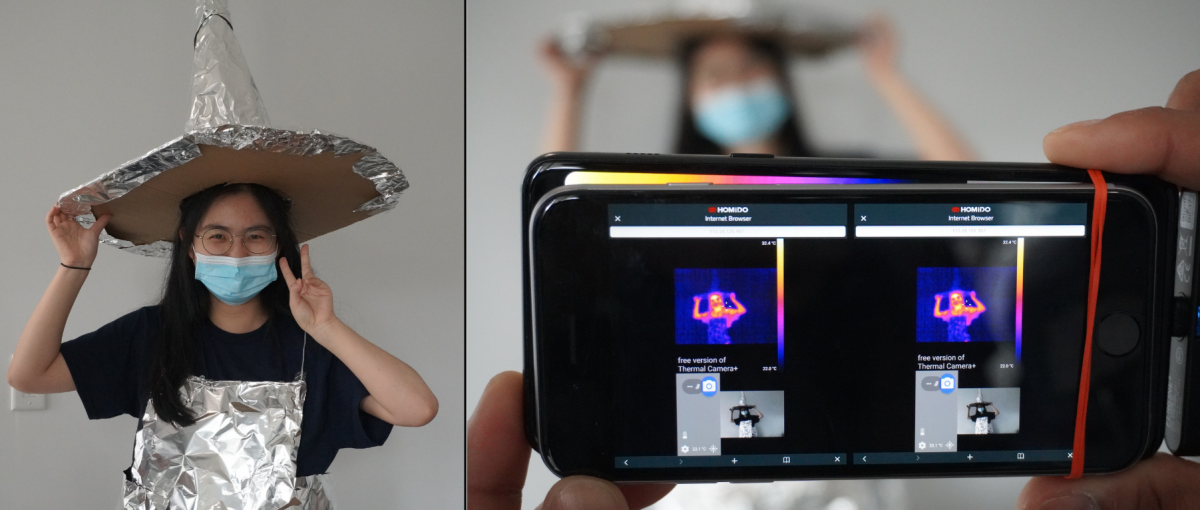
Keyu Wang, a master’s student in the Hsu lab, wore a suit of aluminum foil (left), while workshop participants measured the infrared radiation emitted by both her and the suit (right).
Students learned about lab safety and had an opportunity to tour the Hsu Lab.
Higueros said she is very happy with how the program went and credits the hard work by her lab mates. The event was especially meaningful after the long wait through the pandemic to have it in person. They plan to host others like it in the future.
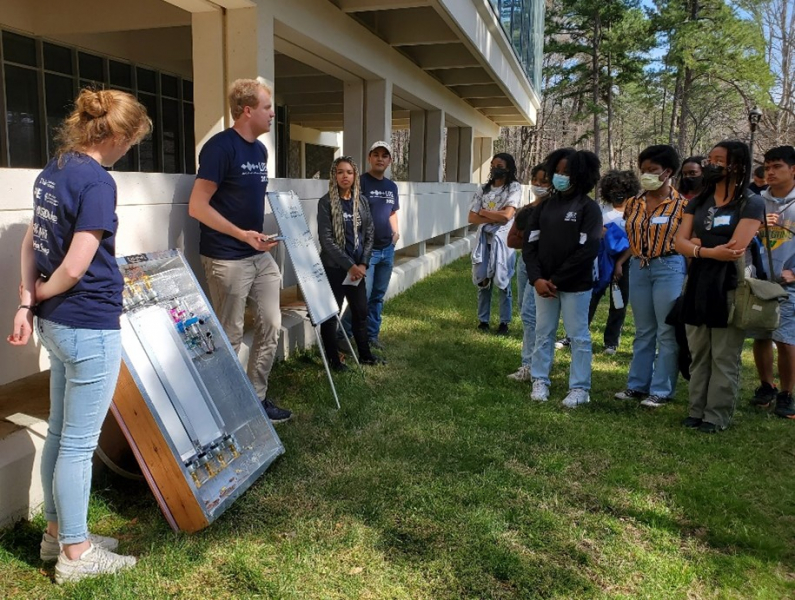
The undergraduate senior capstone group called the Adaptive Team demonstrated their Dual-Mode Solar Thermal Heater & Radiative Cooler project. Team members are McKenzie Garcia, Rebecca Schmitt, Nicole Patterson and David Smoot.
The Hsu Lab gratefully acknowledges funding support for this workshop from the National Science Foundation (Award Number: ECCS 2145933), SPIE Education Outreach Grant (the international society for optics and photonics), Maclin Community Connection Grant (from the Pratt School of Engineering Diversity, Equity, Inclusion & Community Committee) and the Duke University Stores.
(C) Duke University


